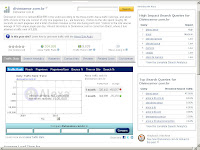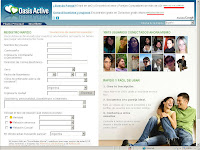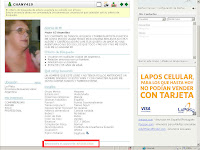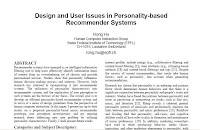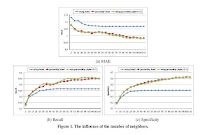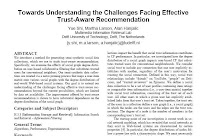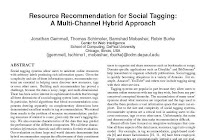Personality Based Recommender Systems include personality traits of their users and need to calculate personality similarity between them in order to make predictions (to recommend products or services)
Personality Based Recommender Systems perform better than Behavioural ones.
Personality Based Recommender Systems assess personality traits of their users in different ways, they can use questionnaires of quizzes, and then they need to calculate personality similarity.
There are several formulas to calculate similarity.
I have discussed some of them in previous posts:
Personality Based Recommender SystemsThe PLAGUE of recommender systems
Recommender Systems and the Social WebIn these papers, they propose a NEW formula to calculate similarity
"Addressing the New User Problem with a Personality Based User Similarity Measure""Personality Based User Similarity Measure for a Collaborative Recommender System""We propose a novel approach for calculating the user similarity for collaborative filtering recommender systems that is based on the big five personality model .... we focus on memory-based (collaborative filtering recommenders) CF systems. CF recommenders are based on the presumption that when the similarity between two users is high both users will like similar items. The similarity measure is thus a crucial part of any CF system.
We propose to use a similarity measure that yields, for each user
u, a list of close neighbours that have in common a similar emotive response pattern to content items. (it lowers the impact of the sparsity problem as the calculation of similarities does not depend on ratings.)
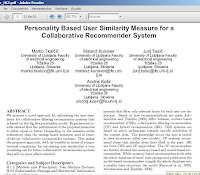

We evaluated the CF using three different user similarity measures:
(i) a standard, rating based measure (equation 8),
(ii) an Euclidian big five based measure (equation 9)
and
(iii) weighted Euclidian big five based measure (equation 10).
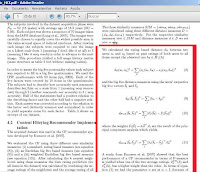
Focusing on the relevant items a classifier yields four groups:
(i) true positives (TP) are items that are relevant to the user and have been correctly classified as relevant,
(ii) true negatives (TN) are items that have been correctly classified as non relevant,
(iii) false positives (FP) are items that are non-relevant but have been misclassified as relevant
and (iv) false negatives (FN) are items that are relevant but have been misclassified as non relevant.
Precision P is the rate of truly relevant items among all the items classified as relevant by the CF system (equation 12)

The F measure combines precision and recall in a single numerical value (equation 14)
We performed an offline experiment of a memory based CF recommender system that relies on end users' personality parameters to determine the nearest neighbours, which is a crucial part of the recommending procedure. We compared four personality based similarity measures and two rating based similarity measures. The CF recommender system's performance results showed that the personality based measures were statistically equivalent or superior (the mean value of F was significantly higher) to the rating based measure.
In terms of mean values of P, R and F the big five based approaches performed better than the ratings based approaches. Table 4 & Figure 3 "
 but guess, it is useless at all for serious dating proposals!!!
but guess, it is useless at all for serious dating proposals!!! It is not going to outperform actual compatibility Matching Methods based on personality profiling.
It will reach as low as 3 to 4 persons recommended -on average- per 1,000 persons screened, the same range as searching by your own, with
high false positives.
You can also read:
"Improving the believability in the interaction of synthetic virtual agents: Towards Personality in Group Dynamics""
Recommender System based on Personality Traits" 142 pages (Uses Big5)

page 24 describes Dating Systems
page 52
3.2.2 Modelling the prototype
In order to generate an effective recommendation, we propose a prototype of a Recommender System that is able to match users' similarities* (or dissimilarities) in Personality Traits.
*Those similarities could be measured considering the fine-grained (6 facets per each Big five dimension) or the coarse-grained (only the 5 dimensions of the Big Five) traits. Indeed, similarities may be measured considering a singular Personality Trait.
page 54
3.2.2.4 Similarity Function
The Similarity Function is in charge of computing the general ranking of facets or dimensions from vectors-ranking. The ranking is projected according to the Decision Module, and
this means that the decision process is projected by the designer of the Recommender System according to the set of traits that should be considered for the recommendation by similarity/
dissimilarity.
3.2.3 Approaches and Techniques
The prototype of our Recommender System was implemented according to the Nearest Neighbor approach. The Nearest Neighbor is an approach used in the Recommender System to optimize the problem of finding closest items to recommend.
(The matching was based on similarity of Personality Traits and the technique applied was the nearest neighbor.)page 77
Other Scenarios for application of Recommender Systems
We present some other scenarios where we can apply Recommender Systems based on Psychological Traits.
Recommending soul-mate in Dating Systems
Recommender Systems based on Personality Traits applied to Dating Systems might be an
alternative for people who search for a compatible romantic mate. Dating Systems which use
psychological aspects to search for compatibility in the recommendations are more likely to
generate successful couples than traditional ones."
Book
"Recommender Systems based on Personality Traits:Could human psychological aspects influence the computer decision-making process?"---------------------------------
"A new similarity measure for collaborative filtering to alleviate the new user cold-starting problem" (DOES NOT include personality traits)
"Collaborative filtering is one of the most successful and widely used methods of automated product recommendation in online stores. The most critical component of the method is the mechanism of finding similarities among users using product ratings data so that products can be recommended based on the similarities. The calculation of similarities has relied on traditional distance and vector similarity measures such as Pearson's correlation and cosine which, however, have been seldom questioned in terms of their effectiveness in the recommendation problem domain. This paper presents
a new heuristic similarity measure"


















